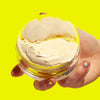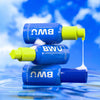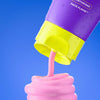David Rooney - July 2022
Skincare from Australia: Understanding Alpha Hydroxy Acid products
Does radiant, hydrated, nourished, bouncy, fresh-looking skin sound nice? Umm yes! Often, Alpha Hydroxy Acid products are a way to make that happen.
When searching for skincare from Australia, you might have come across an intriguing ingredient called Alpha Hydroxy Acids or AHAs. You’re now confused.
What are these acids? What are their benefits? How do I use them? What products are best?
Well, you’ve come to the right place. Let’s run through everything you need to know about Alpha Hydroxy Acid products and their benefits on your skin.

What are Alpha Hydroxy Acids?
Dermatologist and founder of Spotlight on Skin, Julia Rhodes says, “Alpha Hydroxy Acids chemically exfoliate the skin and can assist with collagen remodelling, and can be used to treat acne and hyperpigmentation, amongst other conditions.”
They also have many other benefits, such as hydration, improved skin texture, and reducing the appearance of wrinkles.
How do Alpha Hydroxy Acids Work?
The outer layer of your skin is called the stratum corneum. It’s a protective layer made up of dead skin cells and keratin. Your body naturally exfoliates dead skin cells, but sometimes we need a bit of extra help when there is a build-up. AHAs can penetrate the skin surface and detach dead skin cells, leaving a smooth, glowy appearance.

Alpha Hydroxy Acids List
Dermatologist Julia Rhodes says, “the most commonly used Alpha Hydroxy Acids are Glycolic Acid and Lactic Acid, but there are several others including Citric Acid and Mandelic Acid.”
Glycolic Acid
Glycolic Acid is the gold standard of the AHAs. Along with lactic Acid, it is backed by a lot of research and has been used to treat many skin concerns.
Glycolic Acid has a smaller molecular size than other alpha hydroxy acids and can penetrate deeper into the skin. It’s also a natural humectant, drawing water into the skin and providing a hydrated glow as it exfoliates. It leaves an instant softening of the skin, helping you look fresh and bright.
Lactic Acid
Lactic Acid is very similar to Glycolic Acid. It is slightly slower to work and gentler with a larger molecular size.
It exfoliates the skin and hydrates at the same time. This is an excellent place to start if you are new to acids.
Malic Acid
Malic Acid is larger than Glycolic and Lactic Acids, and plays a significant supporting role in many formulations. Blends with a combination of acids provide a multi-layer exfoliation.
Tartaric Acid
Tartaric Acid is larger in size than Malic Acid and is nearly twice as large as Glycolic Acid. It still provides exfoliation.
Citric Acid
Citric Acid comes from various citrus fruits but also can be made synthetically. It can exfoliate the skin at high percentages but is mainly used in a formula as a pH adjuster (lowering the pH to create an environment where other ingredients work best).
Mandelic Acid
Mandelic Acid is the biggest AHA, meaning slower penetration into the skin. It isn’t commonly used in skincare but can appear from time to time.
AHAs in For Face Sake Facemask
We use AHAs in the Super Soothing U Zone Jelly because of their gentle exfoliating and hydrating abilities.
There are five acids in the formula, including Lactic Acid, Glycolic Acid, Citric Acid, and Malic and Tartaric Acids.
This complex uses a standardised extraction of five plant species: Bilberry, Sugar Cane, Orange, Lemon, and Sugar Maple.
3 Alpha Hydroxy Acid Products We Absolutely Love
Finding the right product for your skin can be a mission. Here are five Alpha Hydroxy Acid products we love.
KP Bump Eraser Body Scrub with 10% AHA
This KP Bump Eraser Body Scrub includes a mix of Glycolic and Lactic Acid at a combined level of 10% with the signature First Aid Beauty Colloidal Oatmeal for extra hydrating and skin-soothing.

Liquid Gold Exfoliating Treatment with 5% Glycolic Acid
This Liquid Gold Exfoliating Treatment contains 5% Glycolic Acid and works to brighten and revitalise tired, ageing skin. It is an excellent pick if you have used an AHA before.

Boring Without You, For Face Sake Facemask (with 6% AHA complex)
Our For Face Sake Facemask is a multi-mask that targets different areas of your face at the same time. Perfect for combo skin pals. Apply the whipped butter to oily parts of your face like your T Zone, and layer the soothing jelly all over your U Zone.
The U Zone jelly is formulated with a 6% AHA complex with various Alpha Hydroxy Acids, designed to gently exfoliate, nourish, and hydrate dry skin – leaving you with a bouncy fresh appearance.

FAQ
Can I use retinol and an AHA at the same time?
We recommend using AHAs at a different time of day to your retinol or tretinoin treatment. If you are using the For Face Sake Facemask, use this in the evening on a day you don’t apply a retinol treatment.
Which is stronger Glycolic or Lactic Acid?
Glycolic Acid has a smaller molecular structure and can penetrate deeper into the skin. It can provide benefits at a faster rate than Lactic Acid.
What is the difference between an AHA and a BHA?
Both are great exfoliants. However, AHAs are water-soluble and, because of their humectant properties, are better for dry skin. BHAs like Salicylic Acid are oil-soluble and can penetrate oily skin and clogged pores.
How many times a week should I use an Alpha Hydroxy Acid?
You should only use your Alpha Hydroxy Acid product twice or three times a week. Any more, and you risk over-exfoliating your skin. Dermatologist Julia Rhodes says “Alpha Hydroxy Acids can increase sun sensitivity, so they are best applied at night.”
Do I need to wear SPF after using an AHA?
Yes! You should wear SPF every day, especially when using an Alpha Hydroxy Acid.






